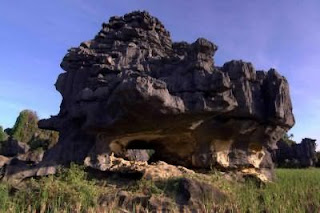After admiring the sunrise over the peaks of East Java, you can descend the same way in approximately 4 hours.
The second route starts at Cemoro Kandang, a short stroll west along the road from Cemoro Sewu, just across the bridge that marks the provincial border. There is also an entry post here where you are required to register.
The Cemoro Kandang route is longer than the Cemoro Sewu trail, about 12 kilometres as opposed to 8 kilometres. However, it is in many ways a more attractive route – the climb is less steep, thanks to a large number of switchbacks; it passes through pleasant forest, and offers more views in its middle sections. It is also a “real” trail, rather than a paved path.
From the check-post the trail rises relatively gently through the forest to Post 1, where there is a hut. Beyond here conditions remain similar until Post 2, another hut where there is also space to camp. It takes between one and two hours to reach Post 2 from the road. In this first section the trail is very well defined, although it is quite badly eroded in places, and muddy during the wet season.
Beyond Post 2 the trail cuts west, and begins to wind its way around the steep western flank of the mountain, passing another unnumbered post with a shelter. Although the forest is quite thick here there are views through the trees down to Tawangmanggu, and, on a clear day, to Solo and Gunung Merapi and Merbabu.
The trail rises up the mountain in a long series of switchbacks, which makes the going easy. Post 3 lies about halfway up the main climb, and beyond here the forest thins and the views become more expansive. The trail is well defined all the way up, though there are places to cut corners on the switchbacks if you’re in a hurry.
The ground levels out at Post 4, and the trail begins to cut around to the northern side of the mountain, remaining level, and actually descending in places. Around 45 minutes from Post 4 a metal sign marks a junction – straight ahead the trail continues to meet the Cemoro Sewu route at Pesanggrahan Argo Dalem, while to the right a short, rough path leads to the summit in around 10 minutes.
Despite being longer, the gentler climbs mean that the Cemoro Kandang route takes about the same time as the main Cemoro Sewu trail. It is possible to reach the summit in under six hours if moving relatively quickly. However, this route is less practical in wet weather (in early 2012 there were a lot of broken branches and fallen trees along the trail, the result of recent high winds, though they did not impede progress).
Given that the two trailheads are so close together, ascending by one route and descending by the other is an attractive option. This would also allow you to make a full circuit of the peak. Alternatively, if you’re feeling very adventurous, head northwest to visit the ancient Candi Ceto temple and then take an ojek or angkot back round to Tawangmanggu (30 minutes). If doing the latter, make sure you have a guide who knows the way as it is much less used than the ascent route from Cemoro Sewu. The Ceto trail strikes north from near Pesanggrahan Argo Dalem and is around 16 kilometres in length.
Jalak Lawu
Jalak Lawu is one of enchanted animal in Lawu mountain. This bird is Lawu mountain endemic animal. However, based on society believe, this bird will follow the climber of Lawu mountain as guide. If the climber did not see Jalak Lawu in his trip, they are believed will be not save or will be lost in Lawu mountain








